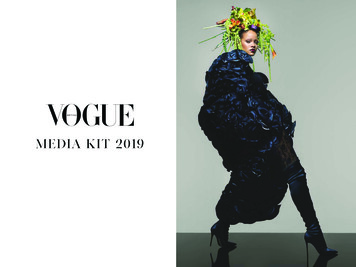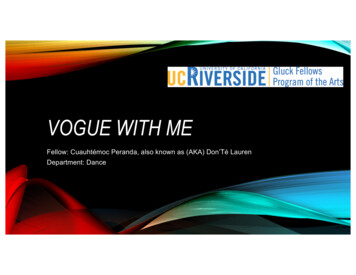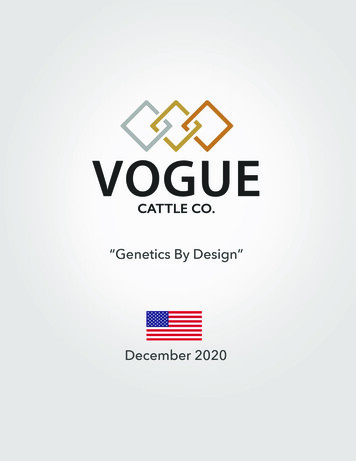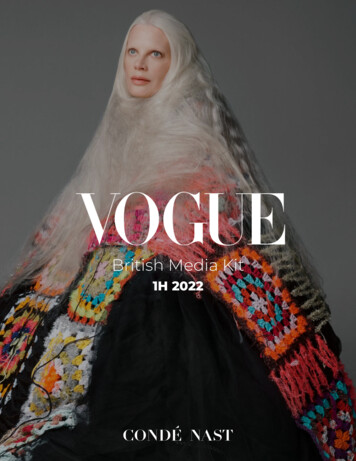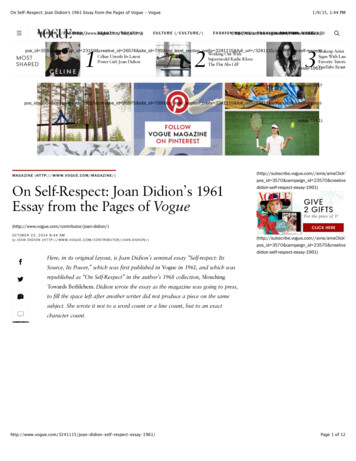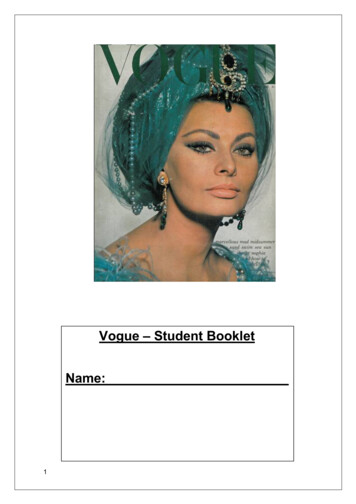
Transcription
Vogue – Student BookletName:1
ContextRead the below industry overviewThe magazine industry has changed significantly since the 1960s when thehistorical set products were published. The marketplace was less crowdedand the industry was dominated by a small number of major publishers.Today, the industry is still dominated by major publishers (such as Hearst, IPC,Bauer) but there is a much wider range of titles available and much greatercompetition for readers.Print circulation is falling and there has been a rise in digital sales. Magazinesneed a strong online and social media presence as well as a clear, uniquebrand identity, in order to compete – many titles, such as Nuts and Loaded,have closed in recent years, and others, such as Company, have becomeonline-only magazines.Woman’s Realm merged with Woman’s Weekly in 2001 as, according toresearch by IPC, it ‘no longer reflected the financially independent lives of itstarget readership’.Many mainstream lifestyle magazines have struggled to survive, howeverthere is now a wider range of niche, or specialised, magazines available andthose that have developed a unique selling point and secured a loyalaudience have been able to succeed.The magazine industry is self-regulated; following the same conventions asnewspapers, with the Editors Code of Practice and the Independent Press StandardsOrganisation (IPSO) setting industry standards.Task: Read the three sources on industry changesSource 1: Article from the Huffington PostThe heyday of the magazine came in the early 20th century, when mega-publisher WilliamRandolph Hearst launched Harper’s Bazaar, Good Housekeeping and National Geographic.Female-targeted Vogue and Vanity Fair followed, bringing fashion and women’s issues tothe forefront of popular culture. Time was founded in 1923. The ’30s brought aboutaspirational magazines like Esquire and Fortune. Widely popular, topical publicationsdirected at niche audiences rolled out in the ’40s and ’50s, including Sports Illustrated andRolling Stone. The ’60s and ’70s gave us the celebrity- and entertainment-focusedmagazines People and Cosmopolitan. In the following decades, magazines diversified, with2
The Face debuting in 1980, Entertainment Weekly in 1990, Wired in 1993. The late 1990sand 2000s brought about the digital revolution. But while newspapers have suffered steepdeclines amid the ride of the Internet, magazines are another story. Across the industry,subscriptions are down, but the picture is more complicated than the overarching numberssuggest. Magazines aren’t dying. About 190 new titles launched in 2014, up from 185 in2013, according to database MediaFinder. While some legacy publications are struggling tokeep their readers, magazines like Glamour, Parents and Better Homes and Gardens allreported increases in paid and verified circulation from 2013 to 2014.Source 2: Data from the National Readership SurveySource 3: Extract from Inside Magazine Publishing by David Stam and Andrew ScottSize of the MarketWhile the magazine market is under attack from some powerful commercial organisations,it is important to be clear that the UK magazine market remains a major media sector andindustry in its own right. Combined research for Inside Magazine Publishing estimates thatannual value of the magazine industry in 2012 to be 3.55 billion. This is split as follows:- Consumers spend 1.8 billion on magazines at retail or via subscriptions.- Print magazine advertising totals a futher 750 million.- Content marketing agencies (the producers of customer magazines) contribute a furhter 1 billion.- There are in excess of 2,400 consumer magazines.Specific Industry 3Published monthly by Condé Nast, 1916 to present.
Set edition: July 1965 Price: 3 shillings (36 old pennies) Women’s magazines became very popular in the post- war period and, in the 1960s,sales of women’s magazines reached 12 million copies per week. Current magazine: http://www.condenast.co.uk/vogue/ Women’s fashion magazine:monthly ‘glossy’, high production values, aspirational. Primarily focused on fashion and style – beauty and design, also cultural focus(theatre, books etc.). The set edition includes a range of articles about travel, money etc. – features ofbroader lifestyle.Research story-and-heritage Condé Nast - Is the publisher a large/mainstream organisation or an independentpublisher? Is the publisher part of a media conglomerate? What other products (magazines or other media products) does the organisationproduce?Access the following websites and watch the clip:4 gazine e-fashion-bible-a-history-ofvogue-magazine/2628/ gue-happy-100th-birthdaymagazine-exhibition -a-brief-history-of-100-years
TASK Summarise the key points relating to why Vogue has attracted and maintained anaudience for over 100 years.5
Key Industry Information6
Target Audience7
Affluent, fashion and style conscious females aged 30-45 Vogue’s media pack defines their audience as: stylish,influential, luxury consumers in their mid-30sHistorical Context – Key PointsIncreased opportunities for women to have jobs – be more than wife or mother.Developments – women attending university – intellectual and financial freedom –greater expectations.Woman realised they were being badly treated – not paid the same as men for example.Advertisements criticised for offering a limited view of women.Betty Friedan (American feminist) – ‘women are shown solely as: men’s wife, mother,love object, dishwasher, cleaner and never as a person’.Women’s rights ‘hot news’ by the end of the 1960s – women’s liberation movement –shocking for some.Demands for equal pay/ opportunities – protests/ marches.Advertisers ‘unsure how to react’ to the women’s movement – advert for intercity –women singing about their rights - but heading home before their husbands find out. TaskRead through the below articles about the 1960s, iew 1945 present 01.shtmlhttp://www.telegraph.co.uk/news/uknews/the queens diamond jubilee/9288411/The-Diamond- /news/article/swinging-sixties/Create a context fact file about the 1960s on the next pageThis needs to summarise key points and facts about the decade. There should be aparticular focus on life in the UK.
Context Fact File:9
Codes, Conventions and RepresentationsTheoryMedia LanguageRepresentationAlvarado’s racial stereotypes:Exotic10
HumorousDangerousPitiedThe following quotes and ideas are taken from a range of sources in relation to women’s magazines.Consider which of these ideas could be applied to the historical issue of Vogue. Consider: cover,contents page, feature articles, advertising.‘There is a depressing stability in thearticulation of women’s politics andcommunication The underlying frame ofreference is that women belong to thefamily and domestic life and men to thesocial world of politics and work; thatfemininity is about care, nurturance andcompassion, and that masculinity is aboutefficiency, rationality and individuality’Liesbet Van Zoonen‘women’s magazines spread a veryuniform picture of women as householdfamily orientated consumers’ JenniferHolt The Ideal Woman‘In promoting a cult of femininity these journalsare not merely reflecting the female role insociety; they are also supplying one source ofdefinitions of, and socialization into, that role.In maintaining the desire of adherents new andold to perfect and display their femininity,these journals can be seen to fulfill another oftheir most enduring purposes - the creation ofprofits for their owners in a market where thefew organizations own the many titles’Marjorie Ferguson, Forever Feminine:Women’s Magazines and the Cult ofFemininityAudience11‘Friedan alleged that magazines did not passivelyparticipate in enforcing these gender roles, butwere in fact an active force behind the creation ofwhat she termed the “feminine monster.” Sheclaimed that the manufacturing sector “haddecided to make women better consumers ofhome products by reinforcing and rewarding theconcept of women’s total fulfillment through therole of housewife and mother”’ Jennifer Holt TheIdeal WomanThe idea that magazines construct ‘mythic’representations of women that ‘representthe better self which every woman desires tobecome’ Jonathan Bignell Media SemioticsMany second wave feminist writers condemnedcontemporary women’s periodicals asperpetuating narrowly defined, socially acceptablegender roles and encouraging conformity to thesenorms’Rachel Ritchie et al: Women in Magazines:Research, Representation, Production andConsumption
Uses and Gratification Developed by Bulmer and Katz suggests that media users play an active role inchoosing and using the media. Bulmer and Katz believed that the user seeksout the media source that best fulfils their needs.The uses and gratifications theory assumes the audience chooses what it wantsto watch for five different reasons.Information and Education – the viewer wants to acquire information,knowledge and understanding by watching programmes like The News orDocumentaries.Entertainment – Viewers watch programmes for enjoyment.Personal Identity - Viewers can recognise a person or product, role modelsthat reflect similar values to themselves and mimic or copy some of theircharacteristics.Integration and social interaction – the ability for media products to producea topic of conversation between people. For example who is the best contestanton The X-factor who which was the best goal shown on Match of the day.Escapism – Computer games and action films let viewers escape their reallives and imagine themselves in those situationsThe video below explains Bulmer and Katz's Uses and Gratifications theory.Two Step Flow12
Two - Step Flow Theory was developed by Katz and Lazarsfeld. The theoryconsists of two steps:Firstly - opinion leaders get information from a media source.Secondly – opinion leaders then pass their own interpretation along to otherssuch as friends and family members (the influenced).Opinion leaders pay close attention to the media and its message. They areinfluential among their peer group as they are usually more informed then theirfriends or family.The influenced are not as well informed and so look up to the opinion leadersand crucially trust their opinion and interpretation of the media.Examples of Two – Step flow theory include elections for example in the 2017UK general Prime Minister Theresa May did not take part in an election debatewith six other party leaders. An opinion leader may have watched the debateand then told their friends who did not watch the debate that the Prime Ministerbottled out as she was scared to debate with the other leaders.Fashion magazines also offer a good example of Two – Step flow theorywhere they act as the opinion leader telling their readers what nextseasons trends are.Rachel Pashley – Types of Women Audience Members13
14
Industry and ContextMagazines Codes15
Magazine Conventions 16Cover (featuring masthead, strapline, main image, cover lines, banner,date, barcode and price)Contents pageEditor’s letterPublishing information pageReaders’ lettersRegular features (relevant to the sub-genre of magazine)Feature articles (double page spread or extended features over severalpages, including headline, stand first, pull quotes/ sidebars, imagesetc.)Advertising, including advertorials
CompetitionsConsistent house style across the magazineTASK - Annotate the Front Cover using the below questions as a prompt:1. What codes and conventions are used?2. Are they typical of magazines?3. Are they typical of Vogue?4. What are the denotations/connotations?5. What representation do they craft?6. Does this support/dispute a theory?7. How far does it reflect the 1960s context?8. How does it position ideal reader to buy magazine? How is it appealingto different audience categories?9. Does it incorporate any other viewpoints or ideologies?Use below to help with your annotations of the front cover:Layout: dominant central image – Sophia Loren, Oscar winning Italian actress, glamorous, atthe height of her fame in the mid 1960s. Lack of cover-lines (list of words) – breaksconventions, focus mainly on a very dominant image of LorenMasthead: over Loren, not very clear but clearly recognisable, iconic magazine brand‘Vogue’ – French word meaning fashion/fashionable, connotations of style, sophisticationLanguage: List of words relating to content – linguistic technique to appeal, emphasise,capture attention Denotation of content of the magazine. Connotations of ‘mad midsummer’– breaking free of conventions/constraints, freedom – hints of the emerging freedoms of the1960s‘sheiks sophia’ – connotations of exoticism/ ‘otherness’ (representation theory)‘scintillate’ – stereotypical norms of femininity/beauty – women need to be ‘scintillating’ inany environment.‘even at a picnic’ – sense that readers will not necessarily have access to glamorous or exoticseaside holidays but that the magazine is relevant for all summer occasions – links to afeature about picnics in the magazineElements of narrative: Enigmas – e.g. what is the link to sheiks?Cover lines: Unconventional list, lower case – more contemporary but unusual for 1965 –sense that Vogue breaks conventions, individual, stands out – appeal to independent womenCentral image: Photograph of Sophia Loren by David Bailey, a still from her latest film.Sophia Loren dominates the front cover17
Direct gaze/mode of address, but aloof (chin slightly raised, not smiling) – connotes starstatus, sense of mystery or mystiqueConnotations of exoticism – Loren’s character dressed as a Turkish dancerSophia Loren is an embodiment of a ‘mythic’ notion of femininity that is aspirational,potentially a sense of the ‘desired self’ that a reader wishes to become.Mise-en-scene: Iridescent turquoise colour palette connotes glamour, luxury, wealth,emphasised by the shimmering scarf, feathers, pearls and jewels.Make-up clearly emphasises Loren’s dark brown eyes, stereotypical notions of female beautyHow does this front cover reflect the social/cultural context?Sense of economic prosperity – luxury, glamour, decadence, ‘mad midsummer’.Cultural context – Sophia Loren, iconic film star of the 1960sInformation on Front Covers1. The front cover is vital in communicating a clear sense of the brand identity of themagazine to the target audience and in appealing to potential readers at thenewsstand.2. In such a competitive print market, magazine front covers need to stand out andattract the attention of potential purchasers.3. It is important that the front cover maintains a clear sense of familiarity for regularreaders but also attracts potential new readers.4. Front covers have a clear set of expected codes and conventions. Mainstreammagazines tend to conform quite closely to these conventions while magazinesproduced outside the commercial mainstream are more likely to challenge or subvertthese conventions.18
TASK Explain to what extent statements 1-4 on the previous page can be supported by theVogue front cover19
TASKNow annotate the following with the same questions you used for the front cover:Use below to help you with annotations of contents pageContents Language e.g. use of alliteration to appeal to audience, repetition of key words/phrases, play on words to link feature articles Features on fashion, style, culture, food/ entertaining, travel – typical features ofwomen’s magazinesTarget Audience: Fashion item ‘op art’ – art link presupposes cultured/ educated reader Assumed interests – fashion, entertaining, culture, image Assumed to have high disposable income – consumerist focus – shopping, trends,travel – cruises Cultural competence – assumes understanding of ‘Dolce Vita’ – Italian for ‘goodlife’, also a filmReflecting social/ cultural/ historical context:20
Focus on ‘exclusive’ places – Spain, Abu Dhabi, Deauville – a time wheninternational travel was becoming accessible but still quite new and a preserve of therelatively wealthy Beauty – ‘suntanning’ article – culturally acceptable in the 1960s Fashion reflecting the culture and trends of the 1960s – pop art/ ‘op art’ Female journalists – professional roles – not necessarily replicated in the assumptionsabout readersOverview Tasks:Bullet point answersDiscuss how Vogue is affected by its historical and cultural contextDiscuss how Vogue reflects its economic context21
Discuss how Vogue reflects its political contextTo what extent does Vogue support Van Noonen’s postulation that “The underlying frameof reference is that women belong to the family and domestic life and men to the socialworld of politics and work; that femininity is about care, nurturance and compassion, andthat masculinity is about efficiency, rationality and individuality”To what extent does Vogue support Gauntlett’s assertion that “in the past the media tended toconvey singular, straightforward messages about ideal types of male and female identities.”22
To what extent does Vogue support Stuart Hall’s view that “stereotyping tends to occur wherethere are inequalities of power, as subordinate or excluded groups are constructed as different or‘other.’”How far could Vogue support Stuart Hall’s theory that there are different ways texts can beread?How far does Vogue support Stuart Hall’s idea that cultivation reinforces mainstream values(dominant ideologies).23
How far does Vogue support Rubicam and Young’s ideas that media producers targetdifferent types of audience membersHow far does Vogue support the uses and gratification theory?How far does Vogue support Curran and Seaton’s ideas about industry?24
Vogue’s media pack defines their audience as: stylish, influential, luxury consumers in their mid-30s Historical Context – Key Points Increased opportunities for women to have jobs – be more than wife or mother. Developments – women attending university – i

